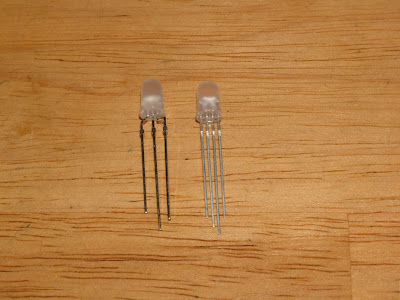Multicolored LEDs
So as part of my shopping adventure at Halted Wednesday, I picked up some multicolored LEDs.
Normal LEDs are pretty ubiquitous. They're in pretty much every computer, and are all the blinking lights you see on network switches and routers. Multicolored ones are pretty much the same, but have more than two wires coming out of them so you can make more than one color.
 So as you can see, the one on the left is a red/green LED. You run current from one side pin to the center one and get red, and from the other side pin to the center and get green. I got four of them, each at 5 cents a piece (a freakin steal!).
So as you can see, the one on the left is a red/green LED. You run current from one side pin to the center one and get red, and from the other side pin to the center and get green. I got four of them, each at 5 cents a piece (a freakin steal!).
The LED on the right is a red/green/blue LED. The longest pin, 2nd from right, is the ground, then each other pin is connected to a different color. It's pretty easy to tell which pin is ground because A) it's the longest, and B) the ground pin is connected to the largest piece of metal inside the plastic dome.
So the really neat thing about these LEDs, although more so with the RBG LED, is that you can get more than just the three colors given. You can start mixing the colors in ratios and get anything from white to purple to orange. This effect has become quite popular lately, my mouse shifts colors, I've see garden lamps do it, as well as frisbees, so now you know what they use to get all the different colors. One little LED.
Normal LEDs are pretty ubiquitous. They're in pretty much every computer, and are all the blinking lights you see on network switches and routers. Multicolored ones are pretty much the same, but have more than two wires coming out of them so you can make more than one color.
 So as you can see, the one on the left is a red/green LED. You run current from one side pin to the center one and get red, and from the other side pin to the center and get green. I got four of them, each at 5 cents a piece (a freakin steal!).
So as you can see, the one on the left is a red/green LED. You run current from one side pin to the center one and get red, and from the other side pin to the center and get green. I got four of them, each at 5 cents a piece (a freakin steal!).The LED on the right is a red/green/blue LED. The longest pin, 2nd from right, is the ground, then each other pin is connected to a different color. It's pretty easy to tell which pin is ground because A) it's the longest, and B) the ground pin is connected to the largest piece of metal inside the plastic dome.
So the really neat thing about these LEDs, although more so with the RBG LED, is that you can get more than just the three colors given. You can start mixing the colors in ratios and get anything from white to purple to orange. This effect has become quite popular lately, my mouse shifts colors, I've see garden lamps do it, as well as frisbees, so now you know what they use to get all the different colors. One little LED.

